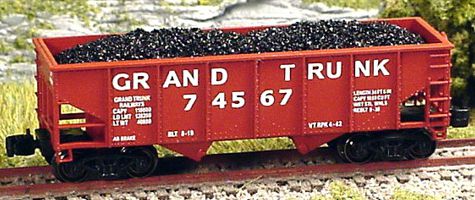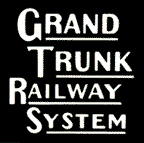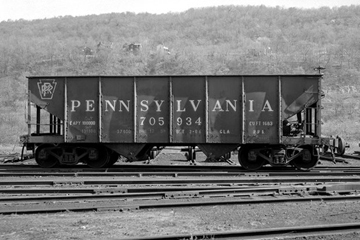Specific Item Information: Road Numbers: GT 74565 & 74567
Model Information: Some of the most common cars to ride American railroad tracks during the 20th Century, the small, steel-paneled, rib-side, two-bay hoppers were instrumental to the growth of our nation. During the Industrial Age of the USA, coal was King and our appetite for "black diamonds" was sated by these pert little dumpsters. An improvement over drop-bottom gondolas, the self-emptying, gravity-release hopper car became reality during the early 1900s, and fed the fires of our burgeoning economy until well after mid-century. While no longer used for large commercial hauling, these mighty-mites are all-pervasive and found on short-lines still lugging coal, gravel, ore, sand, glass and a variety of bulk materials—an invaluable workhorse even for our contemporary railroads. For your Z Scale enjoyment, Full Throttle presents a universal model of these small omnipresent twin-bay hoppers.
Prototype History: The open hopper is an evolution of the gondola, a simple freight car used for the transportation of various materials without and facility for protection from the elements. The hopper had higher sides than the gondola and possessed a mechanism on the bottom (bay doors) for discharging the load.
2-Bay ribside coal hoppers were in common use in the first half of the 20th century. The ribbed sides added stability so the loads would not bow out the side of the hoppers. Steel was in plentiful supply after the second world wars and these cars were pretty much everywhere coal was being produced or consumed.
2-Bay ribside coal hoppers were in common use in the first half of the 20th century. The ribbed sides added stability so the loads would not bow out the side of the hoppers. Steel was in plentiful supply after the second world wars and these cars were pretty much everywhere coal was being produced or consumed.
Road Name History: The Grand Trunk Railway (reporting mark GT) was a railway system that operated in the Canadian provinces of Quebec and Ontario and in the American states of Connecticut, Maine, Michigan, Massachusetts, New Hampshire, and Vermont. The railway was operated from headquarters in Montreal, Quebec, with corporate headquarters in London, England (Warwick House Street). It cost an estimated $160 million to build. The Grand Trunk, its subsidiaries, and the Canadian Government Railways were precursors of today's Canadian National Railways.
GTR's main line ran from Portland, Maine to Montreal, and then from Montreal to Sarnia, Ontario, where it joined its western subsidiary.
The GTR had three important subsidiaries during its lifetime:
Central Vermont Railway which operated in Quebec, Vermont, New Hampshire, Massachusetts, and Connecticut. Grand Trunk Pacific Railway which operated in Northwestern Ontario, Manitoba, Saskatchewan, Alberta, and British Columbia. Grand Trunk Western Railroad which operated in Michigan, Indiana, and Illinois. A fourth subsidiary was the never-completed Southern New England Railway, chartered in 1910, which would have run from a connection with the Central Vermont at Palmer, Massachusetts, to the deep-water, all-weather port of Providence, Rhode Island. A new line to Providence would have allowed for more extensive port facilities than were possible for the Central Vermont at New London, Connecticut. Construction began in 1910 and continued in fits and starts for more than 20 years until finally abandoned in the early 1930s because of the Great Depression. The loss of the SNER's strongest proponent, Grand Trunk Railway president Charles Melville Hays, on RMS Titanic in 1912 may have been the major reason that this new route to the sea was never completed. Another important factor was the unrelenting opposition of the New York, New Haven and Hartford Railroad, which fiercely protected its virtual monopoly control of rail traffic in southern New England.From Wikipedia
GTR's main line ran from Portland, Maine to Montreal, and then from Montreal to Sarnia, Ontario, where it joined its western subsidiary.
The GTR had three important subsidiaries during its lifetime:
Central Vermont Railway which operated in Quebec, Vermont, New Hampshire, Massachusetts, and Connecticut. Grand Trunk Pacific Railway which operated in Northwestern Ontario, Manitoba, Saskatchewan, Alberta, and British Columbia. Grand Trunk Western Railroad which operated in Michigan, Indiana, and Illinois. A fourth subsidiary was the never-completed Southern New England Railway, chartered in 1910, which would have run from a connection with the Central Vermont at Palmer, Massachusetts, to the deep-water, all-weather port of Providence, Rhode Island. A new line to Providence would have allowed for more extensive port facilities than were possible for the Central Vermont at New London, Connecticut. Construction began in 1910 and continued in fits and starts for more than 20 years until finally abandoned in the early 1930s because of the Great Depression. The loss of the SNER's strongest proponent, Grand Trunk Railway president Charles Melville Hays, on RMS Titanic in 1912 may have been the major reason that this new route to the sea was never completed. Another important factor was the unrelenting opposition of the New York, New Haven and Hartford Railroad, which fiercely protected its virtual monopoly control of rail traffic in southern New England.From Wikipedia
Brand/Importer Information:  Greetings, I'm Will, a Fine Arts graduate of Kutztown University in Pennsylvania who grew up in the Delaware Valley. I worked for 30 years with the Pennsylvania German Folklife Society. For ten years I had a permanent booth, each month showing my "PA Dutch" wares, at the country's largest under-roof Antique Market in Atlanta, GA. When Mom and Dad started to have health issues, I was forced to give up the nomadic life, but during my travels I came to love Z Scale Model Railroading, as I could easily take small layouts with me to the motels and play with my trains in the evenings!
Greetings, I'm Will, a Fine Arts graduate of Kutztown University in Pennsylvania who grew up in the Delaware Valley. I worked for 30 years with the Pennsylvania German Folklife Society. For ten years I had a permanent booth, each month showing my "PA Dutch" wares, at the country's largest under-roof Antique Market in Atlanta, GA. When Mom and Dad started to have health issues, I was forced to give up the nomadic life, but during my travels I came to love Z Scale Model Railroading, as I could easily take small layouts with me to the motels and play with my trains in the evenings!
Now that Mom and Dad are gone, and after many years of providing care for my "Pappy" in Florida, I find myself a homebody in the "Sunshine State" with a neat little business, supplying interested Z hobbyists with rolling stock and unique quality products!

Item created by: CNW400 on 2021-08-26 10:15:32
Last edited by: CNW400 on 2021-08-26 10:20:55
If you see errors or missing data in this entry, please feel free to log in and edit it. Anyone with a Gmail account can log in instantly.
Last edited by: CNW400 on 2021-08-26 10:20:55
If you see errors or missing data in this entry, please feel free to log in and edit it. Anyone with a Gmail account can log in instantly.









